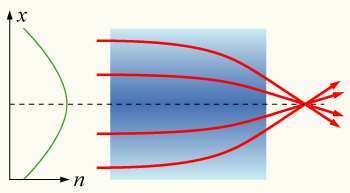Gradient-index optics
The pool is actually an image of the sky, apparently located on the road since light rays are being refracted (bent) from their normal straight path.[4] The flat surface also allows a GRIN lens to be easily optically aligned to a fiber, to produce collimated output, making it applicable for endoscopy as well as for in vivo calcium imaging and optogenetic stimulation in brain.A number of different materials have been used for GRIN lenses including optical glasses, plastics, germanium, zinc selenide, and sodium chloride.[7] An axial gradient lens has been used to concentrate sunlight onto solar cells, capturing as much as 90% of incident light when the sun is not at an optimal angle.[8] GRIN lenses are made by several techniques: In 1854, J C Maxwell suggested a lens whose refractive index distribution would allow for every region of space to be sharply imaged.In 1905, R. W. Wood used a dipping technique creating a gelatin cylinder with a refractive index gradient that varied symmetrically with the radial distance from the axis.
opticsgradientrefractive indexlensesaberrationshuman eyemiragerefractedradio occultationphotocopiersscannerscollimatedendoscopycalcium imaginggermaniumzinc selenidesodium chloridegraded-index fibresmodal dispersionmulti-mode optical fibertotal internal reflectionNeutronChemical vapour depositionpolymerisationmonomerultraviolet lightIon exchangelithiumdiffusionsodiumDirect laser writingJ C MaxwellMaxwell fisheye lensR. W. WoodR. K. LuneburgmicrowaveSelfoc rodsFermat's principleray of lightmediumstationaryCartesian coordinatesSELFOC Microlensoptical axisGraded-index fiberBibcodeGlass transitionSupercoolingAgInSbTeBioglassBorophosphosilicate glassBorosilicate glassCeramic glazeChalcogenide glassCobalt glassCranberry glassCrown glassFlint glassFluorosilicate glassFused quartzGeSbTeGold ruby glassLead glassMilk glassPhosphosilicate glassPhotochromic lens glassSoda–lime glassSodium hexametaphosphateSoluble glassTellurite glassThoriated glassUltra low expansion glassUranium glassVitreous enamelWood's glassGlass-ceramicsBioactive glassCorningWareGlass-ceramic-to-metal sealsZerodurAnnealingChemical vapor depositionGlass batch calculationGlass formingGlass modelingIon implantationLiquidus temperaturesol–gel techniqueVitrificationAchromatDispersionHydrogen darkeningOptical amplifierOptical fiberOptical lens designPhotochromic lensPhotosensitive glassRefractionTransparent materialsAnti-reflective coatingChemically strengthened glassDealkalizationDNA microarrayInsulated glazingPorous glassSelf-cleaning glassTempered glassConservation and restoration of glass objectsGlass-coated wireSafety glassGlass databasesGlass electrodeGlass fiber reinforced concreteGlass ionomer cementGlass microspheresGlass-reinforced plasticGlass clothGlass-to-metal sealPre-pregPrince Rupert's dropsWindshieldGlass fiber